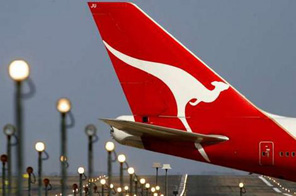Qantas annual profit plummets by 88 pc
SYDNEY: Australian flag-carrier Qantas on Wednesday posted an 88 percent drop in annual net profit to 96.6 million US dollars and unveiled a massive cost-cutting plan to counter the financial beating.
The carrier, which also recorded its first half-year loss in six years, blamed the worse-than-expected results on weaker domestic and international demand for travel wrought by the global financial crisis.
In response, the airline vowed to slash 1.24 billion US dollars of expenditure over the next three years in a bid to boost its ailing bottom line, but was unable to say whether it would remain in profit over the next year.
"There has never been a more volatile and challenging time for the world's aviation industry," Qantas chief executive Alan Joyce said.
Qantas posted a net profit after tax of 117 million Australian dollars (96.6 million US) for the year to June 30, compared to 969 million dollars a year earlier. It recorded a loss of 93 million dollars in the six months to June.
The airline's profit before tax fell a whopping 87 percent to 181 million Australian dollars (149.5 million US) from 1.41 billion a year earlier, but the carrier said it was one of few in the world to produce a full-year profit.
"When most airlines are reporting losses, the Qantas group is reporting a profit for the full year," Joyce said.
"Through unprecedented and significant shifts in operating conditions and demand, we have remained financially strong." Investors reacted positively to the results and cost-cut plans, sending Qantas's share price up five percent to 2.73 Australian dollars in early trade.
Joyce said the financial year to June 30 was one of two contrasting halves, with the first half characterised by a generally favourable operating environment and strong demand.
But the second half was marred by lower passenger numbers and capacity cuts forced by the economic slowdown, he said.
The airline group said weakening demand for travel led to a 4.3 percent decline in yield and a 1.1 percent drop in passenger load, or seats filled, to 79.6 percent, forcing the group to cut capacity by 1.9 percent.
The effects of the economic crisis were compounded by protracted industrial action by Qantas engineers, the swine flu epidemic and costs associated with Qantas' introduction of new Airbus A380 superjumbo aircraft.
The airline said it would cut costs by 1.5 billion Australian dollars (1.24 billion US) over the next three years, starting with a target of 500 million dollars in the year to June 2010.
The cost-slashing exercise, dubbed "Q Future," will target inefficiencies in the areas of sales, fuel conservation, aircraft use, scheduling and procurement, Joyce said.
"We are also keeping a close watch on oil and fuel prices," he said, adding they were volatile and tending to rise.
The airline said that while passenger volumes appeared to have improved and yields had stabilised at the same level as in the first half of 2009, the economy remained very volatile, making it difficult to foresee future results.
"Given the high level of uncertainty, it is not possible to provide any profit guidance," Joyce said. Qantas said it would not pay a final dividend given the uncertain outlook.
Joyce said the airline's negotiation of cancellations and delays to aircraft purchases had helped preserve cash reserves.
But Qantas's budget offshoot, Jetstar, helped prop up the results of the group that controls two-thirds of the Australian market.
Jetstar grew its flight network that includes services to Japan and increased capacity by 14.4 percent in a deteriorating market. And more is to come, Joyce said.
"Investment in Jetstar over the next 12 months, and beyond, will be significant," he said, heralding the purchase of new Airbus A320 and A330-200 planes for use domestically and to Singapore and New Zealand.






